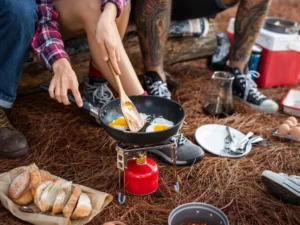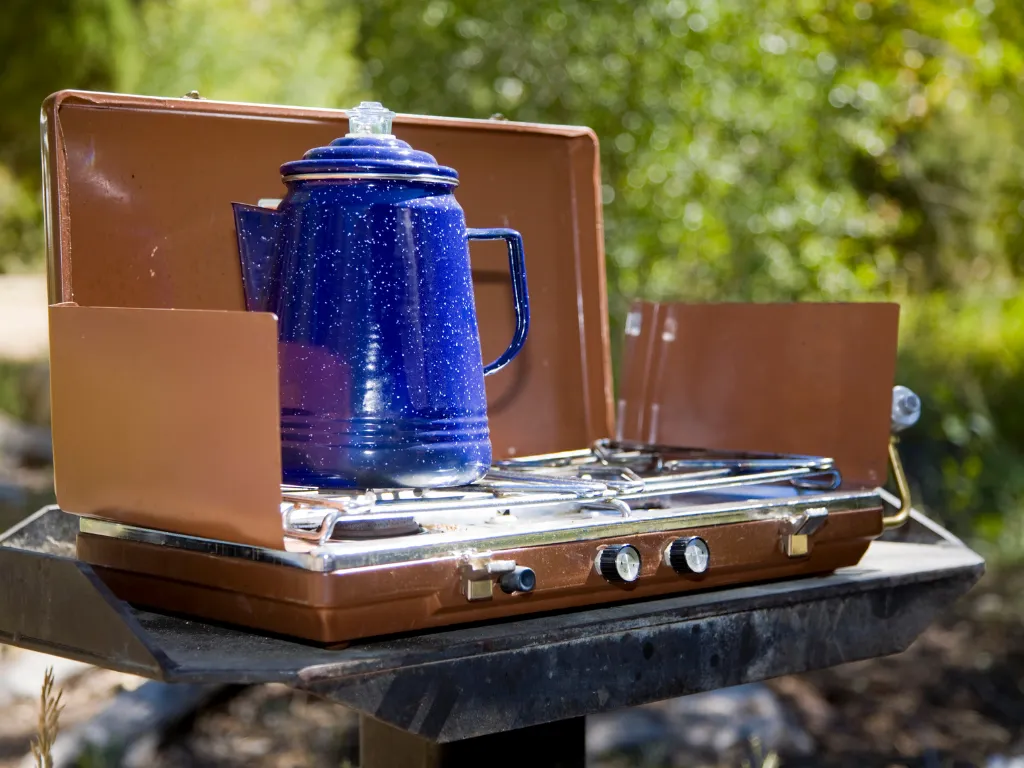camping
Camping hacks for Beginners: 10 Tips for an Eco-Friendly Camp Kitchen

As a camping beginner, you may feel overwhelmed with the task of preparing meals and getting all your camp kitchen gear together. But planning doesn’t have to feel like a daunting task. Here I’ll teach you 10 easy camping hacks to prepare for your next trip while implementing more eco-friendly habits to reduce your overall waste!
Camping Hacks for Beginners: 10 Tips for an Eco-Friendly Camp Kitchen
Table of Contents:
1. Bring reusable tableware
2. Purchase biodegradable soap
3. Bring a water filter
4. Use a portable stove
5. Buy bulk foods
6. Take care of your recyclables
7. Bring reusable water bottles
8. Collect compostable materials
9. Prioritize food storage
10. Keep your campfire safe
1. Bring reusable tableware

My first camping hack for beginners may seem like a no-brainer, but I can’t even tell you the number of times I’ve seen families on outdoor trips carrying around disposable plates and utensils. My own family has been guilty of having this bad habit in the past. We’d pack up our giant bags of throw-away plates and head on out for our weekend camping trips. We’d easily create 3 bags or more of trash for a 2-day trip…Yikes! Instead, you can use disposable tableware made from paper and biodegradable materials. An even better way to be eco-friendly is to invest in a set of reusable tableware. A cook set designed for camping or backpacking makes it especially easy to bring along on any trip. Just make sure to bring along enough plates or utensils for everyone in the group!
2. Purchase biodegradable soap

Using biodegradable soap is a low-impact alternative to regular kitchen soaps. When it’s time to clean up your camp cookware you can use a water reservoir to make the process a breeze. Just fill it up with water, carry it back to camp, place it on the edge of a table (or on the side of a large rock), place a bucket on the ground right under the water spout, and voila! Now you’ve got a place to quickly wash dishes and get back to the fun stuff. Just remember at the end of the day to dispose of that bucket of dirty water properly. This means disposing of the soapy water into a hole, 200 or more feet away from all water sources (streams, rivers, lakes, etc.), where the ground will help decompose it.
3. Bring a water filter

Ever heard of Beaver Fever? I’m talking about Giardiasis, an intestinal infection caused by drinking contaminated water. So, save yourself from horrible diarrhea and get yourself a filter that’s specially designed for backcountry outings. For car camping trips, remember to leave the plastic water bottles at home, or better yet leave them at the store and don’t even buy them. Instead, pack reusable water bottles like Nalgenes or Hydroflasks. Not only do you create less waste, but you’re also avoiding ingesting microscopic pieces of plastic found in most bottled water. Yuck! Likewise, you might want to have a water filter because not all campground water sources are made safe for drinking.
4. Use a portable stove

Wood fires are considered an essential part of having an outdoor camping experience, however, they end up leaving scars on the ground that kill the soil underneath. It’s also going to take you a long time to cook your food. Portable stoves, however, do not impact habitat and you can cook your food more quickly! Plus clean up is faster too. If you want to be even more eco-friendly, you can buy a refillable fuel canister so you don’t create more waste. Portable stoves are very easy to bring along on backpacking trips and are safer to cook with. Out in the backcountry, you may not have a campfire ring to create a wood fire, so bringing along a backpacking stove is the best option.
5. Buy bulk foods

Most grocery stores nowadays offer bulk food supplies where you can find all kinds of yummy treats perfect for outdoor outings. Think of all kinds of trail mix, granola mixes dried fruits, nuts, and my personal favorites: the gummy candies. (Just be prepared for the gummy bear mutations if you’re camping in warm weather!) Single-serving packaged foods create a lot of unnecessary trash and are actually more costly than buying from bulk containers. Just think of how much fewer wrappers you’ll have to keep track of while camping!
6. Take care of your recyclables

For camping trips, I recommend a pop-up recycle bin with sectioned-off compartments. It makes it so much easier to separate aluminum cans from paper, and plastics in one single bin. At the end of the trip, you can just place it in your car trunk and recycle it at home. Some campsites may have recycle bins on site like those for empty fuel canisters or propane canisters. Before dumping everything in you want to make sure that the materials can actually be recycled and remember – NEVER dump flammable liquids in the garbage!
7. Bring reusable water bottles

As I’ve mentioned before, single-use water bottles are a big no-no for outdoor outings! I’m sure the National Parks Service would GREATLY appreciate it if we would all bring reusable water bottles instead on our future wilderness outings. Unfortunately, to this day I still have found those pesky single-use plastic water bottles being dumped on the ground somewhere along my favorite hiking trails. Invest in a durable reusable water bottle like those from Nalgene or HydroFlask. Not only are they made in fun colors but they are also a super fun way to showcase your collection of vinyl stickers!
8. Collect compostable materials

You know those pieces of orange peels you’ve been tossing into the bushes surrounding your camp area because you thought they were “biodegradable?” Well, they are biodegradable BUT they definitely don’t belong on our forest floors and that’s because they aren’t native to most natural environments. Leaving food scraps on the ground disrupts the local ecosystem and it makes it less safe for wandering campers/hikers. Food scraps like those attract the wildlife looking for an extra snack. Make sure to throw all your food scraps into a bin you can take with you and use for composting later back at home.
9. Prioritize food storage

Food storage is important not only for your own safety but as well of the wildlife that may come lurking at your campsite. Practice safe food handling techniques by placing food in a cooler or in your car while you’re away on a hike. In this way, you’ll keep food fresh longer and you won’t come back to your campsite to find critters have been nibbling on your favorite chewy chocolate chip cookies! (I learned my lesson the hard way…sigh). Especially when you’re camping out in the bear country, food storage will be a top priority. Make sure to place your food in large plastic canisters, bear bags, or metal food lockers if you’re staying around a designated campsite.
10. Keep Your Campfire Safe

This is a BIG one!! Forest fires are no joke. We’ve all heard of the recent jump in forest fires occurring in California alone. Be responsible and make sure to take the necessary safety precautions and follow forest service guidelines for campfires. Stop by the Ranger Station before heading over to settle in for camp. Forest Rangers will provide you with any necessary information regarding the wilderness area including the issuing of campfire permits. The forest rangers will want to speak with you to make sure you know important safety tips like using existing campfire rings, keeping a bucket of water and shovel handy, keeping the flames at a max height of 3 feet, and knowing how to properly drown your fire when done.
Eco-friendly camping is all about being aware of the impact you’ll have on the campground after your visit. With these camping hacks, you’ll know that you’ve already reduced that impact before you’ve even arrived at the campground.


